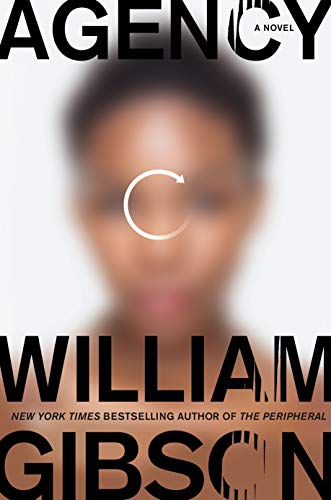William Gibson’s Agency, building on ideas, setting and characters in The Peripheral, is all about the individual’s capacity to act, or agency. Trouble is everyone in the story seems to lack it or at best remains mystified about whether or not they have any agency. So how do you tell a story in which the characters don’t choose their own actions and can’t be sure where those actions are taking them? Or more to the point for readers, what’s it like to experience a novel in which agency seems so elusive?

Since this is Gibson, the ride is always interesting, even fun, despite the fact that everyone is always mostly in the dark about who is calling the shots and why and where it’s all heading. We start off in an alternate 2017 (Clinton won, no Brexit) when Verity, the “app whisperer” in San Francisco, takes a job from a mysterious corporation to evaluate a new headset and eyeglasses.
Abruptly she finds the high-tech rig talking to her in the voice of Eunice, an advanced artificial intelligence, who enlists her in a series of urgent actions of questionable legality. But Verity, for reasons she can’t understand, trusts Eunice and the network of people she is put in contact with. In fact, the decision to trust someone is the closest thing to agency anyone has in this novel.
Before Verity knows exactly what’s going on, she’s on the run from her original employer; Eunice abruptly disappears; and a few people get in touch with her via a strange robot. They claim to be in London. Eventually they make it possible for Verity to visit their world by sending her awareness to inhabit a much more sophisticated android, one that looks human and is considered semi-sentient in its own right. With a shock, Verity realizes that she is visiting the future.
That future is 2136, the timeline and the characters we came to know in The Peripheral. Gibson skillfully alternates short chapters from Verity’s 2017 reality with Wilf Netherton’s 2136. Netherton is a sort of fixer working for the mysterious Ainsley Lowbeer, apparently a London cop, but actually an elegant enforcer for the powers that seem to hold things together. These are referred to as the aunties, powerful algorithms that not only manage things but try to predict the future and make contact with the branching worlds known as stubs.
And there is more than one stub. Verity’s branch of 2017 is threatened by nuclear war that could start any day in the Middle East. But the stub we came to know in The Peripheral has a different president at about the same time (not Trump). One of the characters from that world, named Conner, a war-scarred veteran who likes to shoot guns, appears to Verity in the form of a headless robot that can also contain the voices of Netherton and others from 2136.
As confusing as this might seem, the narrative and plot are less dense than in The Peripheral so there is more time to get a better understanding of the time stubs and the world of 2136. That world has been through the slow degradation and loss of population known as the jackpot. We see it only in glimpses of the future London, largely empty of people, though it has busy neighborhoods of cosplaying real people and semi-sentient androids.
This is a world of vast inequalities in which members of the kleptocracy, known as the klept, are often struggling with each other. But their power seems to be kept in check partly by the aunties and occasional interventions by people like Lowbeer and a nasty nanotech weapon, the tiny swarms of assemblers. These can reduce targeted people to a utility closet (this happens) by changing them at the molecular level.
Characters are pulled into “it”, the central flow of action in the story, either by unwrapping a bizarre package or receiving instructions from Eunice or being summoned to a meeting where a message is passed on to them from someone they trust or work for.
Many of these messages are communicated from one character to another within the often bizarre confines of small but totally secure spaces. There is the cozy interior seating circle of Lowbeer’s car (which is usually cloaked in invisibility), or a yurt made of the cloned skin of a much tattooed character named Ash, or a restaurant table turned into a secure tent by the sparkled draped clothing of a half-dozen androids who can’t form memories.
As the story works toward a climax when we find out a bit more about Eunice, Verity herself is wrapped up in disguise as a package delivered by helicopter to the penthouse apartment of a wealthy tech entrepreneur. Gibson pushes the lack of agency to its limits in that scene, yet things tend to turn out OK. There is a prevailing benevolence in these strange parallel worlds, despite the occasionally murderous inter-klept battles.
The writing is never lackluster and certainly not predictable. Gibson is famous for his detailed descriptions of the tech his characters deal with and often wear. In addition to the spaces his people crawl into, the clothes they wear become just as intricate. Here’s the description of one character who bears a message from Lowbeer to Netherton:
“Now Ash entered, her outfit approximating a Victorian lady’s riding habit, but reimagined as having been cut from nylon aviator jackets and equipped with a demi-bustle that resembled part of a miniature dirigible. She carried a top hat, his least favorite sort of headgear, held just to the side of her multiply zippered black sateen bosom, in what he supposed had once been exactly the correct manner.”
Agency, Penguin Random House hardcover edition p99
Who else would imagine that? Yet the passage and the clothing fit the world of the jackpot where those who have stolen the means (or work for those who have) can indulge their fantasies at almost any scale. Including playing with time through the stubs. Yet the stubs (are these like multiple worlds, branching off at key decision points?) are always in danger of running amok and creating problems for the degraded world of 2136. It takes some strange characters to keep everything in line.
Agency is the second novel in a series. I am hoping there will be more, especially to see what happens with Eunice and Verity and some of the characters from The Peripheral who are only glancingly mentioned in this book.
Gibson always keeps the pace of action going even though I often linger over his strangely beautiful descriptions of the broken worlds he sends us into. They look and feel familiar despite all the differences, and that is quite intentional. As Gibson has often said, his science fiction these days is more about a working out of the forces prevailing in our present than a prediction of the future.




very nice.